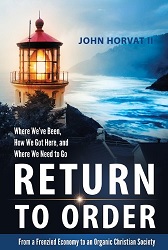
400 pages (Kindle) 169 pages (Paperback)
Publisher: York Press (January 23, 2013)
ISBN:978-0-9882148-1-1
Distributed free through Amazon in Kindle Edition.
Also available in Paperback: www.ReturnToOrder.org
In times of crisis, we are forced to reexamine our ways and ponder our future. It is in this framework that we need to consider our present economic plight and the charting of our path forward.
In his penetrating analysis of contemporary society, author John Horvat focuses on the present crisis with great insight and clarity. He claims modern economy has become cold, impersonal, and out of balance. Gone are the human elements of honor and trust so essential to our daily lives. Society has discarded the natural restraining influence of the human institutions and values that should temper our economic activities.
Return to Order is a clarion call that invites us to reconnect with those institutions and values by applying the timeless principles of an organic Christian order. Horvat presents a refreshing picture of this order, so wonderfully adapted to our human nature. He describes the calming influence of those natural regulating institutions—such as custom, family, community, the Christian State, and the Church.
A return to order is not only possible but crucial. Horvat shows us how to make it happen.
Based on nearly twenty years of ground-breaking research, this book is being recognized as one of the most important and influential on the subject to be published in the past ten years. Its original insight into both the present crisis and remedies for the future thrust Return to Order into the center of the raging debate over how to restore America to prominence as a proud and great nation.
Among its conclusions, this work calls for establishing a common cause in two brief paragraphs:
History records how crisis and adversity have the effect of uniting men in common cause. In fact, no greater bond is forged than when people suffer together, as can be seen in the watine ties among soldiers, or in the struggle for education that unites alumni for life.
Common struggles often initiate changes that would normally take generations to effect. They can give rise to dynamic social, cultural, or religious movements capable of creating new identitities, cementing bonds of solicarity, and forging strong reciprocal relationships. It is not unreasonable to expect that, in the face of the present crisis, similar solutions might emerge.»
Read this dramatic approach to restore America and join the debate about America’s RETURN TO ORDER.